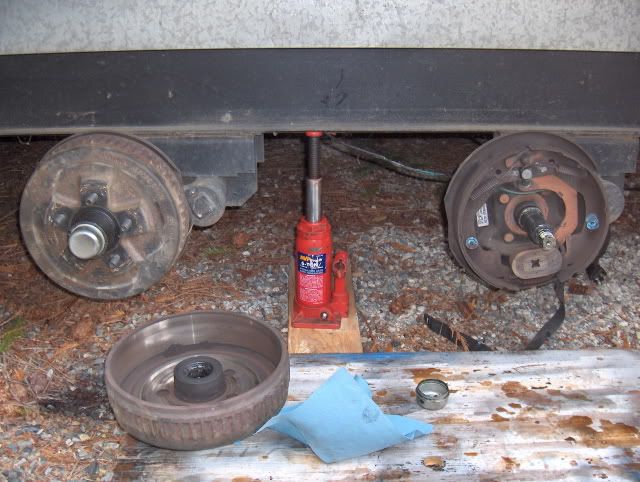- Good Sam Community
- Groups
- Travel Trailer Group
- Forum
- Re: Torque Flex Axals
- Subscribe to RSS Feed
- Mark Topic as New
- Mark Topic as Read
- Float this Topic for Current User
- Bookmark
- Subscribe
- Mute
- Printer Friendly Page
Torque Flex Axals
- Mark as New
- Bookmark
- Subscribe
- Mute
- Subscribe to RSS Feed
- Permalink
- Report Inappropriate Content
Sep-19-2015 09:16 AM
Thanks.
- Mark as New
- Bookmark
- Subscribe
- Mute
- Subscribe to RSS Feed
- Permalink
- Report Inappropriate Content
Sep-20-2015 10:04 AM
I can't say that I have noticed any real difference in the handling between the two types. At least in theory, the idea of the trailer being lower to the ground should result in better handling, but again, for me, from a practical manner there seems to be little to no noticeable difference.
It's true that in time, the rubber rods can and generally do settle and harden. Most folks just replace the entire axle at that time. Common repair when folks are restoring old Airstreams.
- Mark as New
- Bookmark
- Subscribe
- Mute
- Subscribe to RSS Feed
- Permalink
- Report Inappropriate Content
Sep-20-2015 07:35 AM
- Mark as New
- Bookmark
- Subscribe
- Mute
- Subscribe to RSS Feed
- Permalink
- Report Inappropriate Content
Sep-20-2015 07:33 AM
- Mark as New
- Bookmark
- Subscribe
- Mute
- Subscribe to RSS Feed
- Permalink
- Report Inappropriate Content
Sep-20-2015 07:06 AM
Edit: The more I thought about it...I realize that I had the AL-KO version of that type of rubber/torsion axles on mine. The concept is pretty much the same but with 3 pieces of rubber instead of 4.
DW~Patty, no comment
2017 Expedition
2014 Starcraft Launch 21FBS
- Mark as New
- Bookmark
- Subscribe
- Mute
- Subscribe to RSS Feed
- Permalink
- Report Inappropriate Content
Sep-19-2015 12:05 PM
The down side is that the rubber usually lasts 20-25 years and sometime after that timeframe, they start riding rough because the rubber is getting hard. The rubber, in most cases, is not easily replacable, so you need to replace the axle. They don't have an equalizer on tandem axle setups like the leaf springs so that each axle may have to take more of a load than what they are rated for.
Example: If the suspension travel is 5" and you are going over a 7" speed hump, your 8,000# trailer will have all 8,000# (minus the tongue weight) on one axle that may only be rated for 4,000#. Some of the rubber torsion manufacturers recommend rating each individual axle at 1.25 times what the load is intended to be. So your 8,000# trailer should actually use two 5,000# axles.
Some manufacturers don't recommend them for triple axles because the tremendous side load can pull the torsion arm out of the axle tube.
They are a good axle setup and if I found the "right" trailer with them, I wouldn't turn down the trailer because it has a rubber torsion suspension. I prefer the leaf springs with the equalizer on multiple axle trailers. The nicest is the leaf spring split in the center for an independant suspension. These were made by Dexter and are rarely used because it is more expensive and there needs to be a center member on the trailer frame to attach the center pivot point.
1988 Avion Triple Axle Trailer
1969 Avion C-11 Camper
- Mark as New
- Bookmark
- Subscribe
- Mute
- Subscribe to RSS Feed
- Permalink
- Report Inappropriate Content
Sep-19-2015 11:45 AM
'71 Starcraft Wanderstar -- The Cowboy/Hilton
- Mark as New
- Bookmark
- Subscribe
- Mute
- Subscribe to RSS Feed
- Permalink
- Report Inappropriate Content
Sep-19-2015 10:31 AM
but years ago.. I had a popup camper for motorcycles. using a similar system
when the rubber went bad.. special tools and a very large hydraulic press is needed..
being mine came from Europe... not fixable within a normal budget.
- Mark as New
- Bookmark
- Subscribe
- Mute
- Subscribe to RSS Feed
- Permalink
- Report Inappropriate Content
Sep-19-2015 09:32 AM
V-10-4.30 gears Mag-Hytec diff.cover
w/Amsoil-6.0 trans cooler Curt Q5 20K hitch & bedsaver
2005 Keystone Challenger 34TBH-Fifth Airbourn
- Mark as New
- Bookmark
- Subscribe
- Mute
- Subscribe to RSS Feed
- Permalink
- Report Inappropriate Content
Sep-19-2015 09:22 AM
3402 Montana 2013
Ford F350 2015
- Mark as New
- Bookmark
- Subscribe
- Mute
- Subscribe to RSS Feed
- Permalink
- Report Inappropriate Content
Sep-19-2015 09:20 AM
This video describes it all: Dexter Torflex® Suspension Axles
I have never seen them used on an RV, but I will never own another cargo trailer without them. The make the trailer ride smoother.
2018 Arctic Fox 992 with an Onan 2500i "quiet" model generator






